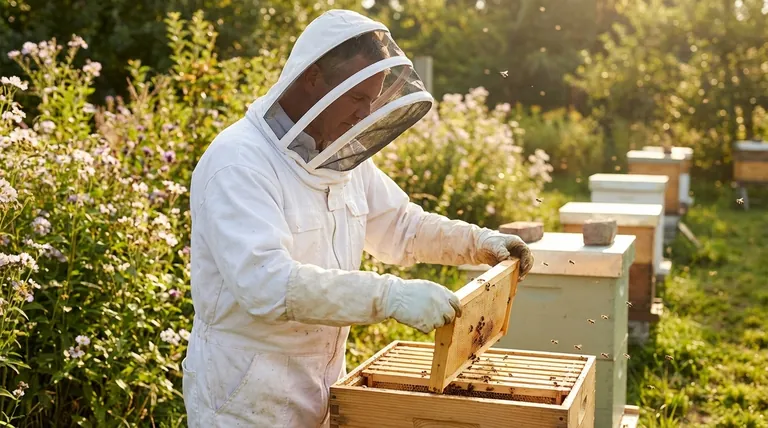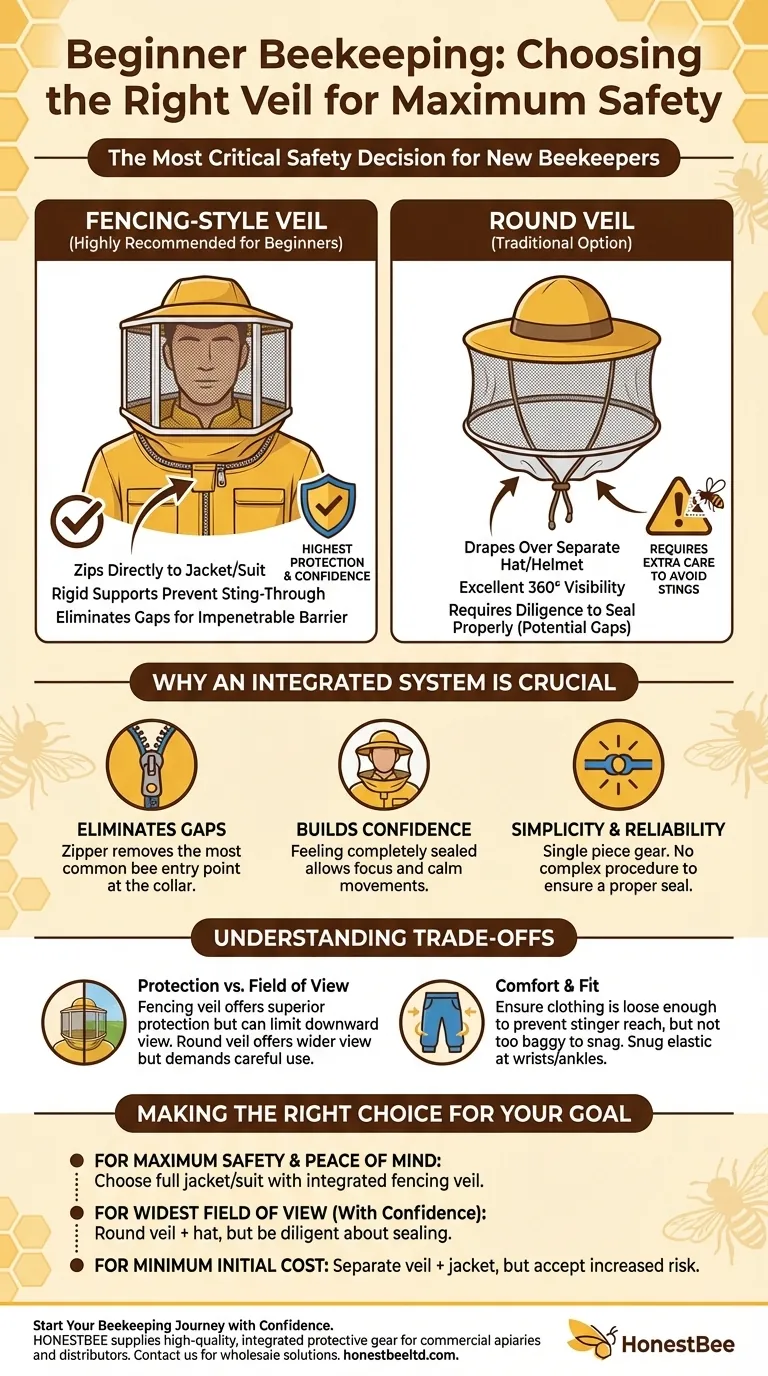Choosing the right beekeeping veil is one of the most critical safety decisions a beginner will make. For new beekeepers, the consensus is clear: a fencing-style veil that zips directly onto a beekeeping jacket or full suit offers the highest level of protection and is the most recommended option for building confidence.
Your veil is not just a piece of mesh; it's the core of your protective system. The fundamental choice for a beginner is between a fully integrated, sealed system that minimizes risk, versus a component-based system that requires more diligence to use safely.

The Two Primary Veil Styles
Understanding the design of each veil type is key to appreciating why one is more suitable for beginners than the other.
The Fencing Veil (Recommended for Beginners)
A fencing veil is structured, much like the mask used in the sport of fencing. It has rigid supports that hold the mesh screening away from your face and neck on all sides.
This design provides a built-in safety buffer. Even if you lean forward, the screen is unlikely to press against your skin, significantly reducing the risk of a bee stinging through the mesh.
Most importantly for beginners, these veils almost always attach with a zipper to a jacket or suit, creating a continuous, impenetrable barrier.
The Round Veil (A Traditional Option)
The round veil is a more traditional style, consisting of a circular piece of mesh that drapes over a separate wide-brimmed hat or helmet.
This style can offer excellent 360-degree visibility. However, its unstructured nature means it can be blown by the wind or sag against your neck or the back of your head if you're not careful.
Securing a round veil to a jacket often involves drawstrings or elastic, which can leave small gaps if not perfectly cinched, creating a potential entry point for a determined bee.
Why an Integrated System is Crucial
For a novice, the feeling of security is paramount. A fully zipped, integrated system provides a level of confidence that separate components cannot match.
Eliminating Gaps
The most common location for a bee to get inside your protective gear is the junction between the veil and the jacket collar. A zipper completely eliminates this weak point.
Building Confidence
Worrying about a bee getting inside your veil is distracting and can lead to hurried, clumsy movements. Feeling completely sealed in allows you to focus on your bees, move calmly, and learn effectively.
Simplicity and Reliability
An integrated suit is a single piece of gear. You zip it up, and you know you are protected. There is no guesswork or complex procedure for ensuring a proper seal every time you approach the hive.
Understanding the Trade-offs
No single piece of equipment is perfect for every situation. It's important to understand the compromises involved.
Protection vs. Field of View
The fencing veil offers superior, foolproof protection but can slightly limit your ability to look straight down. The round veil provides a wider, more open field of view but places a greater burden on the user to ensure it is worn correctly and safely.
Comfort and Fit
Regardless of style, your clothing must fit properly. It should be loose enough that a bee's stinger cannot reach your skin through taut fabric.
At the same time, it should not be so baggy that it snags on hive components. Ensure any elastic at the wrists and ankles is snug but not uncomfortably tight.
Quality of Materials
Pay close attention to the quality of the mesh screen. Good visibility is a key safety feature. A high-quality screen will be easy to see through, while a cheap, dark, or reflective screen can be frustrating and hinder your ability to inspect the colony properly.
Making the Right Choice for Your Goal
Your initial gear selection should be based on your primary goal as you begin your beekeeping journey.
- If your primary focus is maximum safety and peace of mind: Choose a full beekeeping jacket or suit with an integrated, zip-on fencing veil.
- If your primary focus is the widest possible field of view and you are confident in your ability to manage your gear: A round veil with a separate hat is an option, but you must be diligent about sealing the connection to your jacket.
- If your primary focus is keeping initial costs to an absolute minimum: A separate veil and jacket is a viable option, but you must accept and actively manage the increased risk of stings around your neck and collar.
Your protective gear is the foundation of calm, confident beekeeping, so invest in the system that makes you feel the most secure.
Summary Table:
| Veil Style | Best For | Key Feature | Beginner Recommendation |
|---|---|---|---|
| Fencing Veil | Maximum Safety & Confidence | Zips directly to jacket/suit, rigid frame | Highly Recommended |
| Round Veil | Maximum Field of View | Drapes over a hat, 360° visibility | Requires diligent use |
Start Your Beekeeping Journey with Confidence
Equip yourself and your commercial apiary with the safest, most reliable protective gear. HONESTBEE supplies high-quality beekeeping jackets and suits with integrated fencing veils, designed specifically for the needs of commercial beekeepers and equipment distributors.
We provide wholesale-focused solutions to ensure your team operates safely and efficiently. Contact us today to discuss your equipment needs and request a wholesale quote.
Get Your Wholesale Quote & Expert Advice
Visual Guide

Related Products
- Heavy Duty Cowboy Beekeeper Hat with Visibility Veil Outdoor Professional Beekeeping Protective Gear
- Beekeeper Cowboy Hat and Veil for Beekeeping
- Square Folding Bee Hat Veil with String for Beekeeping
- Cotton Beekeeping Suit and Round Hat with Veil Bee Keeper Protective Gear
- Professional Beekeeping Suit for Kids and Girls Childrens Bee Keeper Suit
People Also Ask
- Why are a hat and veil considered the most important parts of beekeeping protective gear? Essential Protection for Your Face and Confidence
- How can beekeeping supplies and accessories enhance the hobby? Essential Tools for Safe & Rewarding Beekeeping
- What activities is the beekeeping hat suitable for? Beyond the Hive for Ultimate Outdoor Protection
- What features enhance the quality of the beekeeping veil? Choose the Right Protection for Your Apiary
- Why is head protection important for beekeepers? Essential Safety for Confident Hive Management



















